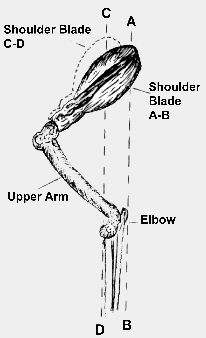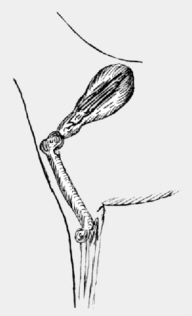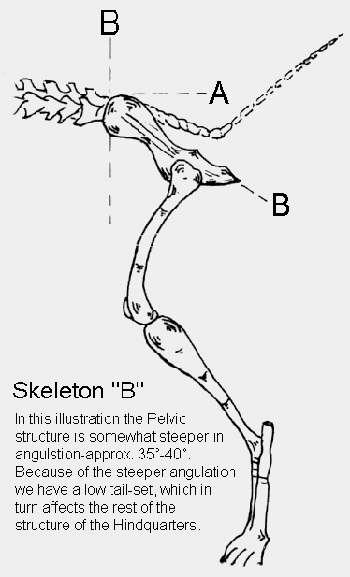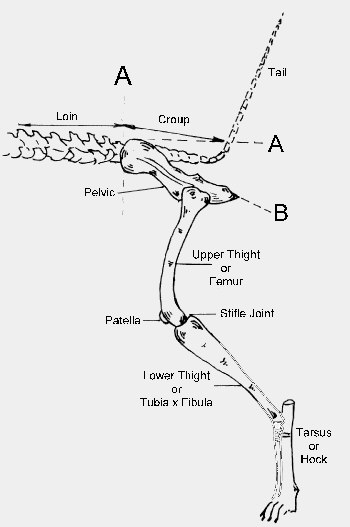| Forehand and Hindquarter from a Cairn | |||||||||
| It is my sincere hope that the following article might be of some help to those lovers of the Cairn Terrier who feel that they need a little help in understanding just what is required in order to obtain a good well balanced front. Not only this, but to recognise both the faults and good points in their dog. My apologies for the sketches, but I have done my best.
First let me establish the work of the forehand in the Cairn and its importance. There are six distinct functions required of the forehand assembley. These are- in the first place to support weight; then to absorb concussion or shock, both from movement and jumping; to propel the body in twists and turns; to offset lateral displacement (rectify balance); to help or even control or maintain the level of the centre of gravity; the 6th function for our breed is that it is an impotant part of the body that assists with the digging and earth removing, when "Our Pal" has gone to ground. |
|||||||||
| It is worth noting that the forehand is not responsible for propulsion in movment, this is provided by the Hindquarters, and the front basically give the dog balance in movment. Carry out a simple study of some of the Cairns you see in the ring, just watch that dog with the flashy high stepping hackney action, is that correct movment for our breed? Look at that one who appears to hestitate with the front leg in mid air and has to draw back the leg before it can place its foot on the ground to complete its step or stride. When you see these types of movment you can safely assume that the construction of the forehand is at fault. Remember that our breed should have fluent movement and appear to float over the ground without any apparent exertion or effort. Should you observe a top line that bobs up and down when the dog is moving, you can once again assume that all is not correct with construction. Some of you might saythat it is extremely difficult to recognise these faults in movment with a small breed such as ours just take your time and with a little patience you will see it.
How can you recognise a correct shoulder, and can you see this with a puppy of 8 weeks? This is a question I´m often asked and my answer is "Indeed you can tell at such a young age". My method is as follows and you might like to try it out and maybe save yourself some heartbreak by keeping a pup until it is more mature and when you show it under a judge who understands about correct anatomy and he/she tells you |
|||||||||
 |
|||||||||
| that your pride and joy "has a shoulder that is far to upright". Or "your dog has insufficient layback". My method is this – place a rubber mat on the table and first accustom the puppy to stand on this, overcoming all fears of standing on such an unnatural surface (incidentally you can purchase one of these rubber car mats from a petrol station). When you are sure that the pup is standing naturally, without collapsing, and with the forelegs as straight as possible and vertically under the shoulder points, gently feel for the point of the shoulder blade at the withers, place your finger on that particular point and keep your finger in place –imagine a vertical line dropping down to the table. If your vertical line falls down to the tip of the elbow, then you can be fairly sure that the angulation of the shoulder blade is correct. Don´t cheat on this because it won´t help. If, however, your vertical line falls in front of the leg, or even to the centre line of the leg, then that important angulation is incorrect. Another simple test is to feel if the top of the shoulder blade comes into the base of the neck, if it does then believe me that is´nt the puppy for you, as later when the pup has matured into an adult you will probably finish up with a stuffy necked Cairn.
What many forget, when assessing the forehand, is that it does not consist just of a shoulder blade, but there is also the upperarm a very important part of the front assembly. Can you also assess if the upperarm is correct in a puppy – again the answer is "YES". When you have the pup standing on the table, gently feel with the thumb and finger where it joins the shoulder blade, and follow it down to the elbow. You can compare the length of it, plus the angulation to the shoulder blade. Remember that the angulation and length should be equal to that of the shoulderblade. It´s really not so difficult to master, all you need is patience both with yourself and the puppy, try it out a few times and you will soon appreciate it can be done. This is the system I have used for some years and would be pleased to demonstrate to anyone that is interested next time I´m on your shows. I´ve made a couple of sketches that might be of help in illustrating the faults. Study the drawings of the two fronts. On front (1) the points A-B are ideal and should be aimed for by every breeder; points C-D show a shoulder that is far too upright, lacking correct angulation. Front (2) is a typical Fox-Terrier front, notice the stepper upperarm resulting in the dog not being able to stand well over its forepaws. Note also the lack of forechest, in our breed you should always keep in mind that the Cairn is an earth dog, therefore the upperarm is important. Freedom of action is most impotant in the task of digging, with a short or badly placed upperarm, freedom of movment will be restricted. A good brisket is also required, because when the Cairn has gone to earth and space is restricted, the dog will work with its brisket on the floor of the hole, giving complete freedom to the upperarm. One should realise that when the upperarm is shorter in length than the shoulder blade, in time nature will take over and the shoulder blade will shorten in length, also become more vertical, losing its angulation. How can you overcome this fault? My answer would be refrain from breeding from an animal with this particular problem. A good well sprung rib cage is of importance, but a round ribcage isn´t true earth terrier construction as the dog would have difficulty in getting down the hole. What is required is a rib structure that has sufficient depth to give plenty of heart and lung room, without this the Cairn will lack stamina. |
|||||||||
| Probably you will say "Why is this man referring constantly to the Cairn going to earth, we no longer put our Cairns down the hole after fox etc.". It is true that seldom do Cairns go to earth these days, but I maintain we should always remember to breed a Cairn that is typical of the race and for the work it was originally intended. If we keep this in mind we shouldn´t really go wrong with our endeavours to breed correct typs.
The last item I would mention is the problem of "loaded shoulders" ; what we should try and breed for is a Cairn with a good clean well laid shoulder. Perhaps the word "clean" is a little misleading, but in doggy terms it refers to a shoulder that lies close to the rib cage, because it is not overloaded with muscle either over , or even under , the blade. Without becoming too technical about muscles, one should realise the importance, and the ones I should like to refer to are those over and under the shoulder blade , the names of these particular muscles are the Trapezius and Rhomboideus. When you come across a dog that has noticeable gap between the two shoulder blade points and you can put your thumb between, this is a fault with the muscle, what has happened is that the Trapezius and Rhomboideus have become somewhat hard and lost elasticity essential for good muscle tone, because the muscle cannot contract ans has hardened. The shoulder blades then instead of being well knit together, are pushed outwards, resulting either in widening of the front or pushing the elbows out. As muscles usually work hand in hand, when the one thickens up, then the other will do likewise, hence the shoulder that is loaded. |
|||||||||
 |
|||||||||
| In conclusion, you should remember that it is no good an animal having powerful hindquarters giving lots of propulsion or drive, if the forehand, because of poor construction, cannot take care of it without being completely disorganised in movment. In other words both forehand and hindquarters should be in harmony with each other. | |||||||||
|
The Hindquarters
|
|||||||||
| When assessing any dog in the ring, one should appreciate the most important and essential attributes for that breed, in our particular breed I would put my priorities in this order – type, followed by soundness in construction. I have no intention to write about the type and have already outlined the forequarters, so this is devoted to the Hindquarters.
The Hindquarters are often described as the engine of the animal, and basically it is true, the hindquarters are the source of the power and locomotion. Without efficient quarters the dog is virtually finished as a working animal and in the past our friend the Cairn was a working terrier, therefore soundness is essential. Let us study the Cairn in movement and decide what we require: the basic outline, make and shape, is described in our Breed standard. For gait or movement it is described thus: - Very free flowing stride, forelegs reaching well forward, hindlegs giving strong propulsion, hocks neither too close or too wide. The description is well worded especially the "very free flowing stride" this tells us exactly what is required and obviously relates to an efficient and well constructed quarter, either fore or hind. Free flowing in no way means that the dog in movement should bob up and down, there should be no apparent disturbance of the topline and the complete picture should be that of a dog floating over the ground with all parts of the anatomy in complete harmony. When observing a dog going away from you, you should be able to see the back pads, when you can see the back pads in movement, it is obvious that the dog is able to flex its hocks and the drive or propulsion is there as we require. Generally the feet should move rather close to the ground, thus avoiding excessive bending of the joints which can be inefficient and tiring for the dog. The back leg is drawn backward by the strongest muscles of the complete assembly, powerful muscules come down from the Pelvis and Croup to the lower thigh. These muscles are so made that they appear to wrap around the quarters which not only draws the stifle joint backwards but also straightens the hock joint. Therefore, if these muscles are not well made or lack condition, the result will be perhaps cow hocks or even a bow shaped rear assembly with the feet somewhat pidgeon toed in stance. You will now appreciate the importance of the muscles of the loin and back and the role they play in movement of the hindquarters. In order to understand the hindquarters, you must apprec - that this does not just refer to the back legs, but the hind assembly is made up of different parts of the anatomy. |
|||||||||
| Loin | |||||||||
| The loin is an important part of any animal and the Cairn is no exception, in our breed we look for a dog completely free from exaggeration so the word medium should apply, and the loin should be neither too long nor too short. What we do want however, is good firm muscle, because this particular part of the body is also related to the correct working of the hindquarters.When studying the topline you should notice a very slight rise over this particular part,this is to be expected as one requires good muscle tone. On the other hand if there is a dip, then this will indicate that the muscles are slack and the efficiency of the loin is somewhat curtailed. A word of warning about Cairns that are ultra short coupled, when this is observed in our breed the result in most cases is that the Cairn cannot move with all four legs travelling on the same line, because it is so short coupled and the dog will move as a crab. If it does not move as a crab then the back feet will strike the front ones and probably trip itself up in the process. Sounds exaggerated, but its perfectly true and the crab like movement has been seen on more than one occasion. | |||||||||
 |
|||||||||
 |
|||||||||
|
Skeleton "A"
This illustrates the "Ideal" angulation of approx. 30° for the Pelvic structure. |
|||||||||
| Croup and pelvic structure | |||||||||
| From the loin we now progress to the Croup and Pelvic structure – first let me explain exactly where the croup is located. The croup is that part over the hip bone or where the Pelvic structure begins and travels down to the tail. The pelvic structure is a shaped bone, and as in the human body, this bone is fused to the spinal column and is one of the most important – if not the most important bone structure in the whole of the hindquarter assembly. Should this be set too steeply then the whole of the hindquarters are ruined for correct angulation, resulting in all sorts of problems i.e. low set tail, lack of bend and stifle, or even shortening of the upper thigh. Perhaps to some it might be a little difficult in assessing the true angulation, but with a little gentle probing with your fingers you can feel where the Pelvis starts and ends. The Pelvic structure finishes just lower, and to each side of the anal passage, we could refer to the end of the Pelvic bone as the “sit point” which in itself is self-explanatory and shouldn´t confuse you.
To assess the angulation of the Pelvis, I suggest you do as I do – stand your dog in a natural relaxed position with the back legs directly under the hips and with hocks straight and vertical (don´t extend the stance into an unnatural position). Now, with your left hand place the palm of the hand over the hipbones or Pelvis, with fingers extended towards the tail. With the right hand feel for the start of the pelvic structure and when you have located this, put your thumb on the point where it begins. Stretch out your fingers until you can locate the “sit point”,by using both hands – the left one as your horizontal and the right one as described, you should be able to ascertain the angulation of the Pelvic structure. For our breed the angulation shouldn´t be too great, as a flattish Croup is required, and the ideal angulation should be approximately 30°. Don´t give up on your first few attemps at discerning the angulation, with a little patience from both yourself and your dog you will be able to master this simple exercise. Remember this is one of the most important bone structures, so it is necessary that you should be able to recognise it. Another point to remember – the length of the Pelvic bone – the longer the better, the more length you have the more muscle you will have. Another important point, (together with correct angulation) is the width between the “sit points”, for obvious reasons a wider pelvic structure is preferable. In the first place one which has sufficient width will ensure that the hindquarters are not too narrow; in bitches a wider pelvic structure means that there is very little restriction when a puppy is actually being born. All this is well worth remembering, so I would urge you to familiarise yourself with this particular part of the dog´s structure. In the past very little has been written about this in the books on the Cairn, and many of our judges (both old and new) seem to be oblivious to the importance of a good pelvic structure. Raed some of the judges critiques and you will find very few make any reference to this, study the techniques used by many judges in going over your dogs, and you will notice that very few pay any attention to this, but on the other hand concentrate only on head, mouth, shoulders and coat!!! The correct pelvis that is not over angulated increases the length of stride and in doing so gives the dog the real zip in movement, it also increases the length of muscle that runs from the Croup to the stifle joint. These muscles are referred to as the “rearing muscles” and must be in good condition in order for the movement to have plenty of power. The set on of the Croup and Pelvic structure is instrumental in govering the amount that the thigh can be drawn back and therefore limits the stride and propulsion. I hope that this section is not too difficult to understand, but you can now appreciate why it is so very important to have a Pelvic structure that is correct in every way. |
|||||||||
| Tail | |||||||||
| In our standard it calls for the tail to be carried gaily neither too high or low with set on, by calling for this carriage we have a tail set allied to the set on of the Pelvic bone giving us the ideal. Remember that the tail is in actual fact a continuation of the spinal column,also, that the Pelvic structure is fused to the spine. Keeping this in mind, then we must have a correct set-on otherwise when a low set on is obvious the the Pelvis is also incorrect in angulation. When one sees that the tail is set on low in a particular dog it is well worth studying movement, in all probability you will observe that the back leg will travel well under the body and even lifting the foot in the direction of the belly, but when it comesto the follow through action, there will be lack of drive or propulsion. Observe also the top line and you will notice that over the hindquarters there is a bobbing up and down, due to the stilted movement. | |||||||||
| Stifle | |||||||||
| A well bend Stifle is essential for good hindquarters, as this means that the bone (tibia and fibula) from the stifle to the hock joint is of good length, ensuring good long tendons and muscles that help in working of the hock joint. | |||||||||
| Patella | |||||||||
| It is a known fact that the Cairn suffers occasionally from Patella luxation, the Patella (knee cap as in humans) is attached to the lower thigh by strands of ligaments. If the binding muscles passing over the knee cap to the lower thigh are slack, or the grooves in the upper thigh are not made correctly, then the knee cap has a tendency to slip out of place, which in turn can cause lameness and in servere cases can be the source of much pain. From what I am led to believe this problem is hereditary therefore, breeding from any affected animal should be stopped. | |||||||||
| Hocks | |||||||||
| It is required in our breed that the hocks are well let down, in other words the length of the hock should be short, as opposed to long. When one sees a Cairn with hocks that are somewhat long, just study the hind movement and you will notice a slight weakness. Remember our Cairn is noted for its ability to keep going for hours on end without becoming fatigued, therefore, the hock that is well let down is preferred because this means more stamina. Our standard states the hock should not turn in or out. Should the dog be inclined to walk somewhat pidgeon toed then this will indicate that the dog is somewhat slack in muscle tone at the Loin. Most of us have seen the cow hocked Cairn, this arises from the fact that the stifle is not working correctly, due to faulty construction, therefore the stifle is pushed outwards resulting in the hock joint being pushed inwards. | |||||||||
| Hind Foot | |||||||||
| This is normally smaller than the front foot, here again care should be taken at a very early stage of the puppy´s development and the nails should be kept short. Well cushioned pads are required to absorb the initial shock of the foot hitting the ground, it is the heel of the pad that first makes contact. The thrust in movement is finally delivered by the toes, Therefore, short nails are essential to build up the strength in the muscles and tendons attached to that part of the foot. A firm compact cushioned foot is of vital importance. | |||||||||
| Text: F.A.E. Skeetches: F.A.E. With kind permission of the CTA (Cairn Terrier Association) 1984 | |||||||||